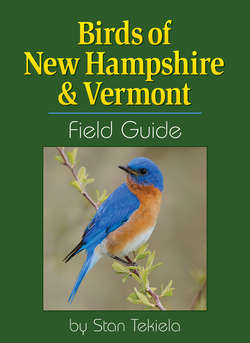Читать книгу Birds of New Hampshire & Vermont Field Guide - Stan Tekiela - Страница 30
На сайте Литреса книга снята с продажи.
Оглавлениеin flight
juvenile
crests
drying
Double-crested Cormorant
Phalacrocorax auritus
MIGRATION
SUMMER
| Size: | 33" (84 cm); up to 4⅓-foot wingspan |
| Male: | Large black water bird with a long snake-like neck. Long gray bill with yellow at the base and a hooked tip. |
| Female: | same as male |
| Juvenile: | lighter brown with a grayish chest and neck |
| Nest: | platform, in a colony; male and female build; 1 brood per year |
| Eggs: | 3-4; bluish white without markings |
| Incubation: | 25-29 days; female and male incubate |
| Fledging: | 37-42 days; male and female feed young |
| Migration: | complete, to southern states, Mexico and Central America |
| Food: | small fish, aquatic insects |
| Compare: | Turkey Vulture is similar in size and also perches on branches with wings open to dry in the sun, but it has a naked red head. American Coot lacks the long neck and long pointed bill. |
Stan’s Notes: Often seen flying in a large V formation. Usually roosts in large groups in trees near water. Swims underwater to catch fish, holding its wings at its sides. Lacks the oil gland that keeps feathers from becoming waterlogged. To dry off, it strikes an erect pose with wings outstretched, facing the sun. The common name refers to the two crests on its head, which are not usually seen. “Cormorant” comes from the Latin words corvus, meaning “crow,” and L. marinus, meaning “pertaining to the sea,” literally, “Sea Crow.”
